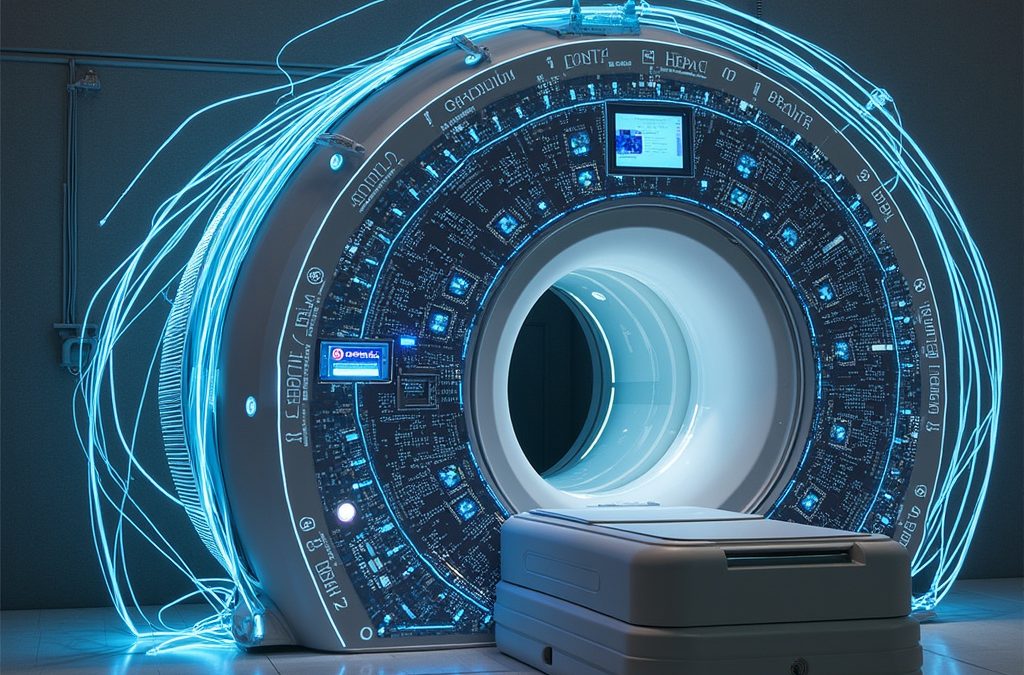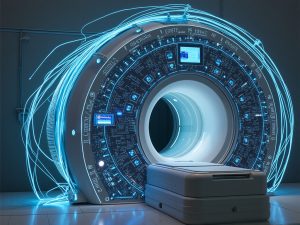Gadolinium, a rare earth metal, serves as a contrast agent in MRI scans, enhancing the visibility of internal structures. This enhancement is crucial for diagnosing various conditions, including cancers, by providing clearer images of organs, tissues, and blood vessels.
The process of an MRI with gadolinium contrast, as applied in my case for diagnosing CNS Lymphoma, involves multiple non-contrast scans initially. These scans provide a baseline view of the brain’s structure. Following this, gadolinium is administered through an IV.
Gadolinium’s purpose is to enhance areas where the blood-brain barrier might be disrupted, such as in tumors, by making them appear brighter on MRI images. This contrast injection happens after initial scans are complete, allowing for comparison between the pre-and post-contrast images, which is crucial for identifying active disease areas. The repetition of this process over a week in my case was presumably to monitor rapid changes or responses to initial treatments, though the necessity of such frequency remains a point of personal contention and medical curiosity.
My experience with gadolinium was not through standard diagnostic procedures but was thrust upon me due to an urgent diagnosis of Central Nervous System Lymphoma (CNS Lymphoma), a rare form of brain cancer. This critical situation, treated at a premier medical research center, necessitated three MRIs with gadolinium contrast within my first week.
The FDA’s directive suggests that in such scenarios, the medical urgency might supersede the standard protocols for obtaining informed consent for gadolinium administration, highlighting how exceptional circumstances can dictate medical decision-making. At the time, I was unaware of the possible adverse side effects of gadolinium.
Gadolinium Poisoning
The pivotal moment in my understanding came several months ago during a casual conversation with a medical technician as I was being prepared for another MRI. He casually mentioned that gadolinium, the contrast agent used in my scans, is a rare earth element.
This sparked a deep dive into research, unveiling the potential long-term effects of gadolinium retention. Gadolinium poisoning, or gadolinium deposition disease, presents risks often under-discussed, with symptoms ranging from skin thickening to neurological issues like brain fog, muscle pain, and cognitive impairments. These symptoms might not manifest immediately but can emerge over time, particularly with repeated exposure, underscoring the necessity for cautious use and monitoring. Gadolinium deposits have been found in the brain.
Having just removed lymphoma from the center of my brain, the idea of introducing more elements into that now vulnerable area seemed counterintuitive to me. Despite reassurances from my doctor, the absence of routine testing for gadolinium levels in patients like myself, especially in a facility conducting trials on gadolinium exposure with non-patient participants, felt like a betrayal of trust.”
Betrayal of Trust
This was compounded by the FDA’s 2018 Drug Safety Communication regarding gadolinium, which was intended to inform healthcare professionals and patients about the risks associated with gadolinium-based contrast agents (GBCAs). A review of the of document below reveals this communication was poorly structured, inconsistent, and unclear. It includes the following paragraph1:
“All MRI centers should provide a Medication Guide the first time an outpatient receives a GBCA injection or when the information is substantially changed. In general, hospital inpatients are not required to receive a Medication Guide unless the patient or caregiver requests it. A health care professional who determines that it is not in a patient’s best interest to receive a Medication Guide because of significant concerns about its effects may direct that it not be provided to that patient; however, the Medication Guide should be provided to any patient who requests the information. (emphasis in bold is mine).
This lack of clarity not only undermines informed consent but also erodes the trust patients place in medical institutions and especially in regulatory bodies.
Things I could do…armed with knowledge, I took charge of my health. The decision to forgo further chemotherapy, focusing instead on resolving dental issues as a suspected root cause for my cancer was met with resistance. My insistence on understanding my gadolinium levels through a urine test marked my final and transition from patient to advocate. The results were alarming, prompting a reevaluation of my treatment plan and a decision to not undergo further exposure to gadolinium.
My experience underscores a critical need for transparency in medical practices and the competency of government agencies. Patients deserve not just treatment but also understanding—not just diagnosis but dialogue. The medical practice must evolve to include routine monitoring for gadolinium retention, especially in patients undergoing multiple scans. Moreover, the discussions around medical procedures should include not only benefits but also potential risks.
Conclusion
In conclusion, this essay isn’t just a recount of personal medical trials but a call to action for healthcare reform. As we advance in medical technology, let us not forget the human element, ensuring that the tools meant to heal do not inadvertently harm. My story with gadolinium is one of many, advocating for a future where medical care is as transparent as the images it seeks to produce.
- FDA Drug Safety Communication: FDA warns gadolinium-based contrast agents (GBCAs) are retained in the body. May 16, 2018. Accessed: -09/24/2024 https://www.fda.gov/drugs/drug-safety-and-availability/fda-drug-safety-communication-fda-warns-gadolinium-based-contrast-agents-gbcas-are-retained-body
Additional References Consulted:
Qu H, Li W, Wu Z, et al. Differences in hypersensitivity reactions and gadolinium deposition disease/symptoms associated with gadolinium exposure to gadolinium-based contrast agents: new insights based on global databases VigiBase, FAERS, and IQVIA-MIDAS. BMC Med. 2024;22:329. https://doi.org/10.1186/s12916-024-03537-2
Yao X, Hu J, et al. Deposition of gadolinium in the central and peripheral nervous systems and its effects on sensory, cognitive, and athletic implications after multiple injections of gadolinium-based contrast agents in rats. Am J Neuroradiol. 2024;45(8):1153-1161. DOI: 10.3174/ajnr.A8295.
Multihance (gadobenate dimeglumine). Princeton, NJ: Bracco Diagnostics Inc; 2024. Available from: https://www.accessdata.fda.gov/drugsatfda_docs/label/2024/021357s027,021358s025lbl.pdf
NOTE: When I sought urine tests to measure gadolinium levels, my doctors were unwilling to order them, relying instead on a mathematical calculation they believed sufficient. Determined to understand my body’s gadolinium burden, I purchased the tests myself online — item 3527, Comprehensive Urine Element Profile. This test also offers valuable insight into 33 elements, including lead, mercury, aluminum, arsenic, iron, zinc, calcium, and more. I’ve had success with True Health Labs (https://truehealthlabs.com) for ordering and processing these tests at home. Read the instructions carefully — it takes some planning. These tests are not covered by insurance or Medicare.
An “acceptable” gadolinium level is generally considered to be ≤ 0.019 mcg/g creatinine, though ranges may vary slightly by lab. My last MRI with contrast was on July 16, 2024. Since then, I’ve undergone three separate urine analyses to track my gadolinium levels over time:
Gadolinium Test Results
– August 14, 2024: 11.664 mcg/g creatinine – Severely elevated
– November 5, 2024: 0.500 mcg/g creatinine – Improved, but still high
– June 16, 2025: 0.25 mcg/g creatinine (24-hour collection) – Within normal range per lab standards
This trajectory has been encouraging. The downward trend suggests that my body is slowly clearing the gadolinium burden, possibly aided by lifestyle changes, detox protocols, or simply time. However, contrary to common assumptions, these foreign substances can remain in the body far longer than expected, and the full extent of their potential impact on human health remains uncertain. This journey of self-advocacy has been eye-opening, and I share these details to empower others navigating similar challenges.

Linda Wulf
My journey with CNS lymphoma not only shaped my perspective on health but ignited a mission to uncover and educate about the myriad chemicals we encounter every day.










